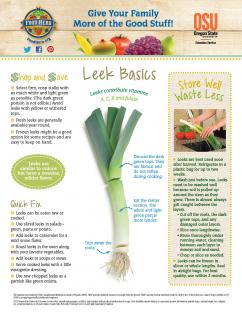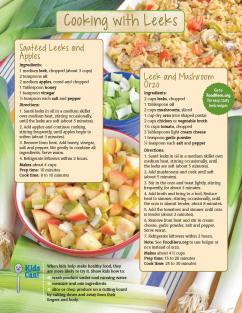Leek Basics
Leeks contribute vitamins A, C, K and folate.
Leeks are similar to onions but have a sweeter, milder flavor.
Shop and Save
- Select firm, crisp stalks with as much white and light green as possible. (The dark green portion is not edible.) Avoid leeks with yellow or withered tops.
- Fresh leeks are generally available year round.
- Frozen leeks might be a good option for some recipes and are easy to keep on hand.
Store Well Waste Less
- Leeks are best used soon after harvest. Refrigerate in a plastic bag for up to two weeks.
- Wash just before use. Leeks need to be washed well because soil is pulled up around the stem as they grow. There is almost always grit caught between the layers.
- Cut off the roots, the dark green tops, and any damaged outer layers.
- Slice once lengthwise.
- Rinse thoroughly under running water, cleaning between each layer to remove soil and sand.
- Chop or slice as needed.
- Leeks can be frozen in slices or whole lengths. Seal in airtight bags. For best quality, use within 3 months
Quick Fix
- Leeks can be eaten raw or cooked.
- Use sliced leeks in salads–green, pasta or potato.
- Add leeks to casseroles for a mild onion flavor.
- Roast leeks in the oven along with your favorite vegetables.
- Add leeks to soups or stews.
- Serve cooked leeks with a little vinaigrette dressing.
- Use raw chopped leeks as a garnish like green onions.
Cooking with Leeks
Recipes
Sautéed Leeks and Apples
Leek and Mushroom Orzo
Kids Can!
When kids help make healthy food, they are more likely to try it. Show kids how to:
- wash produce under cool running water.
- measure and mix ingredients.
- slice or chop produce on a cutting board by cutting down and away from their fingers and body.







